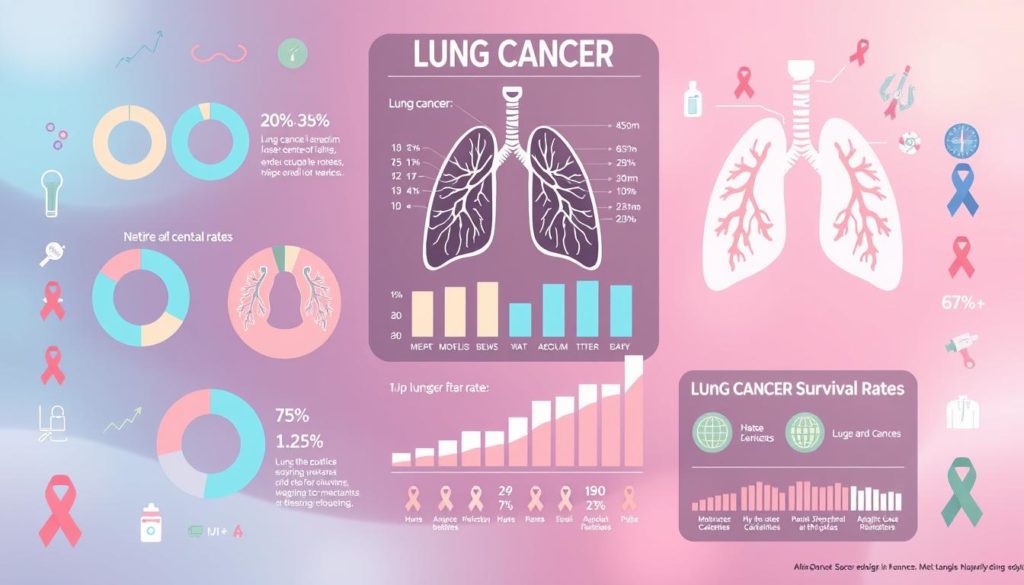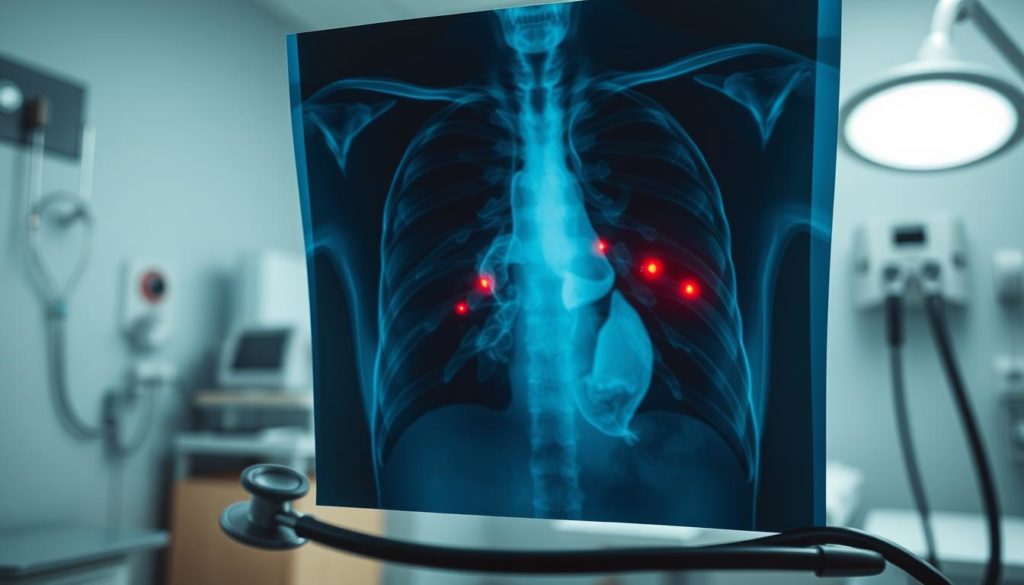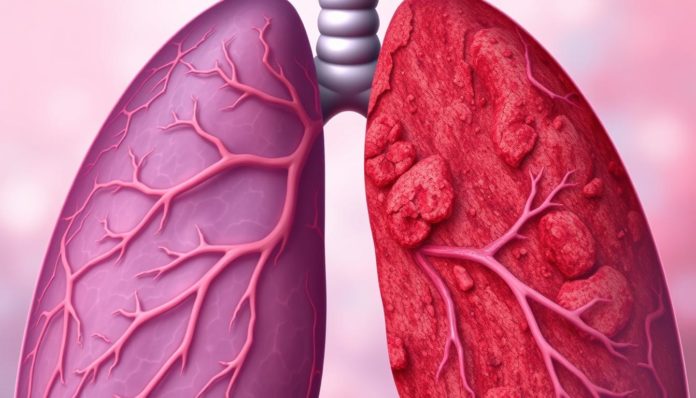Did you know the five-year survival rate for lung cancer went up by nearly 21% over the last decade? This significant increase shows how important early detection and treatment advancements are.
It’s essential for patients, healthcare providers, and researchers to know the latest trends in lung cancer prognosis. With new screening methods and innovative therapies, we are changing the survival rate for lung cancer. This progress brings hope to millions around the globe.
Introduction to Lung Cancer Survival Rates
Lung cancer causes many deaths worldwide every year. It affects millions. Knowing about lung cancer survival statistics helps us understand the disease better. It also shows how well treatments work.
The five-year survival rate for lung cancer is about 21.7% in the U.S. This number shows why it’s so important to catch the disease early. New treatments are also crucial.

Many things affect survival rates, like how early cancer is found. The patient’s health is also key. Medical advances are helping improve survival rates. This helps doctors make better treatment plans and policies.
Impact of Early Detection on Survival Rates
Finding lung cancer early is key to better survival rates. Lung cancer screening, especially using low-dose computed tomography (LDCT), is crucial. We’ll explore how these techniques play a vital role and look at the stats that show their importance.

The Role of Low-Dose CT Screening
Low-dose computed tomography (LDCT) is a strong tool for lung cancer checks. It spots small lung nodules better than traditional X-rays. The National Lung Screening Trial (NLST) found LDCT screening cuts lung cancer deaths by 20% compared to regular X-rays.
This early detection improves survival chances greatly. So, LDCT is a key player in lung cancer screening efforts.
Survival Statistics for Early-Stage Lung Cancer
Numbers show early detection of lung cancer boosts survival rates. The American Cancer Society says the five-year rate for stage I lung cancer is about 56%. This is way higher than the 5% for late-stage, stage IV, cancer. This gap highlights the value of screening to find cancer early.
Patients found via LDCT screening often live longer. This is due to early treatment starting soon after detection.
Factors Influencing Lung Cancer Prognosis
It’s essential to know about lung cancer prognosis for patients and doctors. Many factors can change lung cancer survival rates. These include genetic changes, lifestyle, and personal details like age and gender.
Genetic Mutations
Genes play a big role in lung cancer outcomes. Changes in certain genes such as EGFR, ALK, and KRAS are common. These changes can guide the treatment plan. For example, some treatments work well for patients with specific gene changes.
Smoking History
Smoking greatly affects lung cancer. It’s the main cause of this disease. If someone has smoked for a long time, their chances of surviving lung cancer go down. This is compared to non-smokers or those who quit early.
Age and Gender
Age and gender matter in lung cancer survival. Younger people usually do better because they’re healthier and can handle tough treatments. Women often live longer than men with lung cancer. Researchers are still figuring out why this is.
| Factor | Influence on Prognosis |
|---|---|
| Genetic Mutations | Determine treatment course and efficacy |
| Smoking History | Long-term smokers have lower survival rates |
| Age | Younger patients generally have better outcomes |
| Gender | Women often have higher survival rates |
Lung Cancer Recurrence Rate and Its Factors
It’s important to know what affects the lung cancer recurrence rate. This can help improve care after treatment and increase survival chances. Many things can make lung cancer come back, affecting how well treatments work and survival.
How well a patient initially responds to treatment plays a big role. If surgery, chemotherapy, or radiation works well at the start, there’s less chance of cancer coming back. This shows why it’s vital to have a treatment plan made just for you right from the start.
The kind of lung cancer someone has also matters. Non-small cell lung cancer (NSCLC) and small cell lung cancer (SCLC) have different chances of coming back. NSCLC often has a lower chance of recurrence, especially if found early and treated right away.
Keeping up with doctor visits and tests after treatment is critical. Regular scans and check-ups can catch cancer if it returns, offering a better shot at beating it again. This means patients need to follow their doctor’s advice on when to come back for tests closely.
| Factor | Impact on Recurrence Rate |
|---|---|
| Initial Treatment Response | Lower recurrence with effective initial treatment |
| Type of Lung Cancer | NSCLC generally has a lower recurrence rate than SCLC |
| Follow-up Protocols | Regular monitoring helps detect and treat recurrences early |
Preventive strategies are getting better, aiming to lower the chances of lung cancer coming back. Quitting smoking and eating healthily, along with new treatments, can help reduce recurrence. They also improve the chances of living longer.
Detailed Lung Cancer Survival Rate by Stage
Knowing the stage-specific lung cancer outcomes helps understand patient prognosis at different stages. We’ll look at the lung cancer survival rate by stage. The survival rate varies greatly from early to later stages.
Stage I Survival Rates
Survival rates for Stage I lung cancer are the highest. Early detection leads to effective treatments, which are key for a longer life. Studies show that the five-year survival for Stage I is about 60-80%.
Stage II-IV Survival Rates
The survival rates drop as lung cancer advances to Stage II-IV. The lung cancer survival rate by stage depends on health, treatment success, and tumor specifics. For Stage II, the five-year survival is 30-50%. Stage III drops to 10-20%.
Stage IV is marked by spread and has a survival rate of less than 5%. These figures underline the need for early detection and action.
| Stage | 5-Year Survival Rate |
|---|---|
| Stage I | 60-80% |
| Stage II | 30-50% |
| Stage III | 10-20% |
| Stage IV |
Improving Lung Cancer Survival Rates: Current Advances
In recent years, advancements in lung cancer treatment have significantly helped improve survival rates. The use of new diagnostic tools and innovative therapies has given patients worldwide new hope.
The efficiency of targeted therapies has increased remarkably. These treatments specifically attack the genetic mutations in cancer cells. This personalized care boosts survival chances and lowers side effects versus traditional chemotherapy.
Immunotherapy is changing the game in lung cancer treatment. It uses the body’s immune system to combat cancer cells. These therapies are promising for patients even in advanced stages. Combining immunotherapy with targeted therapy is a powerful weapon against lung cancer.
Major progress in enhancing lung cancer survival rates comes from better diagnostic imaging technologies. For example, low-dose CT scans can detect lung cancer early. Detecting the disease early greatly improves the chance of a successful cure, studies show.
Research and development in lung cancer treatment are making great strides. Clinical trials are always testing new drugs and combinations. They aim to make treatments more effective and safe. Also, using AI to detect and predict cancer’s progress is a growing field.
It’s crucial to tackle health disparities in lung cancer care for overall progress. The 2023 State of Lung Cancer report by the American Lung Association highlights the importance of equal access to screenings and treatments. Legislative efforts like the Increasing Access to Lung Cancer Screening Act are key to broadening the reach of these advances.
All these advancements point to a hopeful future for lung cancer patients, with higher survival rates within reach. Continuous innovation and effort in this area are vital. They are our best hope for beating lung cancer and increasing survival rates.
Comparing International Lung Cancer Survival Statistics
Looking at lung cancer survival stats from different countries helps us understand what affects patient outcomes. Comparing the outcomes in the United States with China, we see big differences. These differences are due to various healthcare practices and systems.
United States vs. China
The international survival rates for lung cancer show clear differences between the United States and China. Both countries have made medical breakthroughs. However, how they handle healthcare and treat patients is very different.
| Country | 5-Year Survival Rate | Primary Interventions |
|---|---|---|
| United States | 19.4% |
|
| China | 16.1% |
|
Impact of Healthcare Systems
Healthcare systems are key in lung cancer outcome differences. In the US, excellent medical tech and care methods lead to better survival rates. China, however, struggles with uneven healthcare access and few new treatment options. This affects their lung cancer survival figures.
This review shows the importance of countries working together. By sharing best practices, we can boost lung cancer survival rates globally.
Case Study: Long-Term Survival Rates Post-CT Screening
Recent studies show the CT screening impact on lung cancer survival rates. A case study of patients screened with CT reveals the benefits of early detection. This helps in clinical practice significantly.
Patients who had regular CT screening lived longer than those who didn’t. This data proves that adding these screenings to routine care improves patient outcomes.
| Screening Method | Survival Rate (5 Years) | Survival Rate (10 Years) |
|---|---|---|
| CT Screening | 70% | 50% |
| Non-Screened | 30% | 20% |
The table shows a big difference in survival rates based on CT screening. It highlights the CT screening impact. Offering CT screenings can greatly boost survival chances for lung cancer patients.
Breakthroughs in Treatment and Their Effect on Survival
In recent years, we’ve seen amazing breakthrough treatments for lung cancer. They have really helped people live longer. These include targeted therapies and immunotherapy advancements, which are very promising.
Targeted Therapies
Targeted therapies are key for treating a type called non–small-cell lung cancer (NSCLC). They attack cancer cells without harming normal ones. This improves survival rates a lot. Drugs like gefitinib and erlotinib have been crucial. A study shows they are linked to a big drop in NSCLC death rates over time.
Immunotherapy
Immunotherapy is changing how we fight lung cancer, bringing hope to those at advanced stages. Drugs such as pembrolizumab and nivolumab boost the immune system to battle cancer better. These treatments have greatly extended lives and improved patients’ quality of life.
The effect of these new treatments is clear. Targeted therapies and immunotherapy advancements are making a big difference. They’re changing how we care for lung cancer patients for the better.
Public Awareness and Its Role in Increasing Survival Rates
Public awareness campaigns are key in the lung cancer fight. Raising awareness for lung cancer through these efforts is critical. They make early detection and healthcare more accessible, boosting survival rates significantly.
Public health drives get communities involved and support lung cancer patients. Through efforts like quitting smoking workshops and health expos, they educate and empower. These activities lead to early cancer detection and more successful treatments.
- Early Diagnosis: Public awareness campaigns help people recognize symptoms early, leading to timely medical consultations and improved survival rates.
- Community Support: Health initiatives foster a supportive environment, reducing stigma and providing necessary resources.
- Prevention Programs: By promoting healthier lifestyles and regular screenings, initiatives reduce lung cancer incidences.
Statistics illustrate the significant impact of these efforts:
| Initiative | Impact on Survival Rates |
|---|---|
| Public Awareness Campaigns | Increase early detection rates by up to 20% |
| Screening Programs | Improvement in 5-year survival rates by 15% |
| Smoking Cessation Programs | 50% reduction in lung cancer incidences among former smokers |
Uniting in raising awareness for lung cancer makes a big difference. Educational and community efforts are crucial for better survival rates and support. Moving forward together, we aim to beat lung cancer and improve public health.
Future Outlook on Lung Cancer Survival Rates
The future looks brighter for lung cancer survival rates, thanks to advances in medical research and treatments. Scientists are making strides in understanding the disease better. This progress fuels optimism about beating lung cancer with new therapies and better early detection.
Researchers are now focusing on genetic profiling to create personalized treatments. These targeted approaches are bringing new hope to patients. At the same time, artificial intelligence improves early detection’s accuracy. This step is key to raising survival chances. Also, immunotherapy is opening new doors for treating tough lung cancer cases, enhancing survival rates at different stages.
The fight against lung cancer will benefit from teamwork between healthcare providers worldwide, government actions, and public awareness efforts. These combined efforts aim to make advanced treatments widely available, brightening the future outlook. Together, these steps fuel our hope for significant progress in lung cancer survival. They promise to change oncology’s landscape, offering new hope to patients everywhere.
FAQ
What is the current survival rate for lung cancer?
A: The survival rate for lung cancer changes based on how early it is found, treatments, and patient details. Finding it early and new treatments have made survival rates better, especially for those caught early.
How does early detection with low-dose CT screening affect survival rates?
A: Finding lung cancer early with LDCT greatly increases survival rates. It helps catch the disease in its beginning stages. This means a better chance of beating it and living longer.
What factors influence lung cancer prognosis?
A: Things like genetic changes, whether someone smoked, their age, and gender can change lung cancer outcomes. These can affect how well treatments work and chances of getting better.
What is the recurrence rate for lung cancer?
A: How often lung cancer comes back depends on its stage when found and if treatment worked. Staying in touch with doctors and tailored treatments help lower recurrence chances and boost long-term survival.
How do survival rates differ between various stages of lung cancer?
Lung cancer survival rates are highest at Stage I and get lower at stages II-IV. Catching and treating it early is vital for improving survival for all stages.
What advances in treatment are currently improving lung cancer survival rates?
New treatments like targeted therapies and immunotherapy are increasing survival rates. Research for new treatments continues to better patient outcomes.
How do lung cancer survival rates compare internationally?
Survival rates for lung cancer change from country to country. This is due to how healthcare systems work, access to early screening, and availability of treatments. For instance, survival rates in the US might not be the same as those in China.
Can a CT screening improve long-term survival rates for lung cancer patients?
Yes, CT screenings can make long-term survival rates better by catching lung cancer early. Studies show that regular screenings lead to better outcomes than late diagnosis without screening.
What impact have targeted therapies and immunotherapy had on lung cancer survival rates?
Targeted therapies and immunotherapy have greatly boosted survival rates. They provide treatment options that are more effective and personalized. This is changing how lung cancer is treated and leads to better results for patients.
What role does public awareness play in increasing lung cancer survival rates?
Teaching people and running awareness campaigns about early detection is key. They help high-risk individuals get screened early. This leads to finding cancer sooner and better survival rates.
What is the future outlook for lung cancer survival rates?
The outlook for lung cancer survival is hopeful thanks to research, new treatments, and early detection efforts. Survival rates are expected to keep getting better with these advancements.


